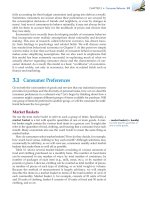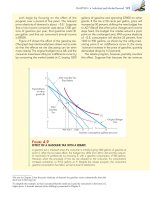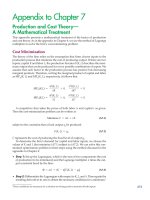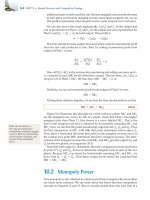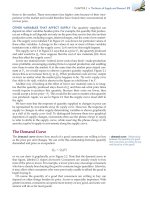(8th edition) (the pearson series in economics) robert pindyck, daniel rubinfeld microecon 110
Bạn đang xem bản rút gọn của tài liệu. Xem và tải ngay bản đầy đủ của tài liệu tại đây (120.65 KB, 1 trang )
CHAPTER 3 • Consumer Behavior 85
PRICE CHANGES What happens to the budget line if the price of one
good changes but the price of the other does not? We can use the equation
C ϭ (I/PC) − (PF/PC)F to describe the effects of a change in the price of food on
the budget line. Suppose the price of food falls by half, from $1 to $0.50. In that
case, the vertical intercept of the budget line remains unchanged, although the
slope changes from −PF/PC ϭ Ϫ$1/$2 ϭ Ϫ$1/2 to Ϫ$0.50/$2 ϭ Ϫ$1/4. In
Figure 3.12, we obtain the new budget line L2 by rotating the original budget line L1 outward, pivoting from the C-intercept. This rotation makes sense
because a person who consumes only clothing and no food is unaffected by
the price change. However, someone who consumes a large amount of food
will experience an increase in his purchasing power. Because of the decline
in the price of food, the maximum amount of food that can be purchased has
doubled.
On the other hand, when the price of food doubles from $1 to $2, the budget
line rotates inward to line L3 because the person’s purchasing power has diminished. Again, a person who consumed only clothing would be unaffected by the
food price increase.
What happens if the prices of both food and clothing change, but in a way
that leaves the ratio of the two prices unchanged? Because the slope of the budget line is equal to the ratio of the two prices, the slope will remain the same. The
intercept of the budget line must shift so that the new line is parallel to the old
one. For example, if the prices of both goods fall by half, then the slope of the
budget line does not change. However, both intercepts double, and the budget
line is shifted outward.
This exercise tells us something about the determinants of a consumer’s
purchasing power—her ability to generate utility through the purchase of goods
and services. Purchasing power is determined not only by income, but also
by prices. For example, our consumer’s purchasing power can double either
because her income doubles or because the prices of all the goods that she buys
fall by half.
Finally, consider what happens if everything doubles—the prices of both
food and clothing and the consumer’s income. (This can happen in an inflationary economy.) Because both prices have doubled, the ratio of the prices has not
changed; neither, therefore, has the slope of the budget line. Because the price
of clothing has doubled along with income, the maximum amount of clothing that can be purchased (represented by the vertical intercept of the budget
Clothing
(units per
week)
F IGURE 3.12
EFFECTS OF A CHANGE
IN PRICE ON THE
BUDGET LINE
40
L3
L1
(PF = 2)
40
L2
(PF = 1 )
2
(PF = 1)
80
120
Food
160
(units per week)
A change in the price of one good (with income
unchanged) causes the budget line to rotate
about one intercept. When the price of food
falls from $1.00 to $0.50, the budget line rotates
outward from L1 to L2. However, when the price
increases from $1.00 to $2.00, the line rotates
inward from L1 to L3.

